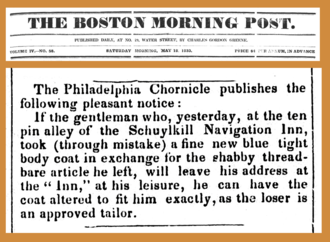Tongue-in-cheek

Tongue-in-cheek is a figure of speech used to imply that a statement or other production is humorously or otherwise not seriously intended, and it should not be taken at face value. The phrase originally implies a physical gesture of putting one's tongue in one's cheek to signal contempt, but has since evolved to denote a subtler form of sarcasm or ironic understatement.
Origin[edit]
The exact origin of the phrase "tongue-in-cheek" is not well-documented, but it is believed to have originated in the 18th century. The gesture was used as a way of indicating that what was being said was not to be taken seriously, either because it was untrue or because it was an understatement. Over time, the physical gesture became less common, but the phrase remained part of the English language, retaining its original meaning.
Usage[edit]
"Tongue-in-cheek" is often used to describe a manner of speaking, writing, or behaving. When someone makes a tongue-in-cheek comment, they are often being playful, ironic, or sarcastic. The intention is to convey amusement or to gently mock a subject, rather than to cause offense. This form of expression is common in various forms of media, including literature, film, and television, as well as in everyday conversation.
In literature, authors may use a tongue-in-cheek style to critique social norms or to add layers of meaning to their work. In film and television, characters might make tongue-in-cheek remarks to highlight the absurdity of a situation or to engage the audience in a more intimate way, by letting them in on the joke.
Recognition and Interpretation[edit]
Recognizing when something is said or done tongue-in-cheek can sometimes be challenging, especially in written form where tone and facial expressions are absent. Clues that a statement is meant to be taken tongue-in-cheek include the context in which it is said, the relationship between the speaker and the audience, and the presence of known sarcasm indicators, such as exaggerated statements or clearly implausible assertions.
Interpreting tongue-in-cheek remarks correctly requires a level of cultural and contextual awareness. What is considered humorous or sarcastic can vary greatly between different cultures and social groups, making the tongue-in-cheek expression a nuanced form of communication.
In Popular Culture[edit]
Tongue-in-cheek humor has a significant place in popular culture, often used to add a layer of wit or to critique societal norms and expectations. It is a common tool in satire and parody, genres that rely heavily on irony and exaggeration to make their point.
Conclusion[edit]
Tongue-in-cheek expressions serve as a reminder of the complexity and playfulness of human communication. They highlight the importance of context, tone, and mutual understanding in interpreting meaning. As a form of expression, tongue-in-cheek remarks can bridge the gap between humor and critique, offering a unique way to engage with and reflect on the world around us.

This article is a linguistics stub. You can help WikiMD by expanding it!
Ad. Transform your life with W8MD's Budget GLP-1 injections from $75


W8MD offers a medical weight loss program to lose weight in Philadelphia. Our physician-supervised medical weight loss provides:
- Weight loss injections in NYC (generic and brand names):
- Zepbound / Mounjaro, Wegovy / Ozempic, Saxenda
- Most insurances accepted or discounted self-pay rates. We will obtain insurance prior authorizations if needed.
- Generic GLP1 weight loss injections from $75 for the starting dose.
- Also offer prescription weight loss medications including Phentermine, Qsymia, Diethylpropion, Contrave etc.
NYC weight loss doctor appointmentsNYC weight loss doctor appointments
Start your NYC weight loss journey today at our NYC medical weight loss and Philadelphia medical weight loss clinics.
- Call 718-946-5500 to lose weight in NYC or for medical weight loss in Philadelphia 215-676-2334.
- Tags:NYC medical weight loss, Philadelphia lose weight Zepbound NYC, Budget GLP1 weight loss injections, Wegovy Philadelphia, Wegovy NYC, Philadelphia medical weight loss, Brookly weight loss and Wegovy NYC
|
WikiMD's Wellness Encyclopedia |
| Let Food Be Thy Medicine Medicine Thy Food - Hippocrates |
Medical Disclaimer: WikiMD is not a substitute for professional medical advice. The information on WikiMD is provided as an information resource only, may be incorrect, outdated or misleading, and is not to be used or relied on for any diagnostic or treatment purposes. Please consult your health care provider before making any healthcare decisions or for guidance about a specific medical condition. WikiMD expressly disclaims responsibility, and shall have no liability, for any damages, loss, injury, or liability whatsoever suffered as a result of your reliance on the information contained in this site. By visiting this site you agree to the foregoing terms and conditions, which may from time to time be changed or supplemented by WikiMD. If you do not agree to the foregoing terms and conditions, you should not enter or use this site. See full disclaimer.
Credits:Most images are courtesy of Wikimedia commons, and templates, categories Wikipedia, licensed under CC BY SA or similar.
Translate this page: - East Asian
中文,
日本,
한국어,
South Asian
हिन्दी,
தமிழ்,
తెలుగు,
Urdu,
ಕನ್ನಡ,
Southeast Asian
Indonesian,
Vietnamese,
Thai,
မြန်မာဘာသာ,
বাংলা
European
español,
Deutsch,
français,
Greek,
português do Brasil,
polski,
română,
русский,
Nederlands,
norsk,
svenska,
suomi,
Italian
Middle Eastern & African
عربى,
Turkish,
Persian,
Hebrew,
Afrikaans,
isiZulu,
Kiswahili,
Other
Bulgarian,
Hungarian,
Czech,
Swedish,
മലയാളം,
मराठी,
ਪੰਜਾਬੀ,
ગુજરાતી,
Portuguese,
Ukrainian